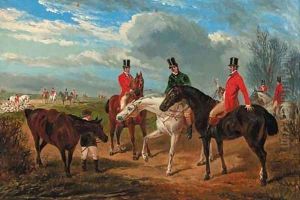John Frederick Jun Herring Paintings
John Frederick Herring Sr., born in 1795 in London, England, was an esteemed painter, particularly renowned for his depictions of horses and rural life. His detailed and realistic portrayals of equine subjects have made him one of the 19th century's most revered English equestrian artists. Herring's journey into the art world was unconventional; he initially embarked on a career as a coachman, a profession that undoubtedly fostered his profound connection with horses.
Herring's artistic career began to flourish in the 1820s, after his talent for painting was discovered. He started receiving commissions from affluent patrons, including members of the British aristocracy, for whom he painted portraits of horses and rural scenes. By the mid-19th century, Herring had established himself as a leading equestrian artist, alongside contemporaries such as George Stubbs and Sir Alfred Munnings. His works were highly sought after, and he enjoyed considerable success during his lifetime.
In addition to his equestrian paintings, Herring also produced a number of rural landscapes and scenes depicting country life. His work is characterized by its attention to detail, vibrant colors, and the ability to capture the dynamic essence of horses in motion. Herring's paintings often featured hunting scenes, agricultural activities, and racing events, reflecting his deep appreciation for the English countryside and its traditions.
John Frederick Herring Sr. passed away in 1865, leaving behind a legacy that has endured in the art world. His sons, John Frederick Herring Jr., Charles Herring, and Benjamin Herring, also became painters, continuing the family tradition of capturing the beauty of rural life and the animal kingdom. Today, Herring Sr.'s works are held in high regard, with his paintings featured in art collections and museums around the world, testament to his enduring influence on the genre of animal and equestrian art.
